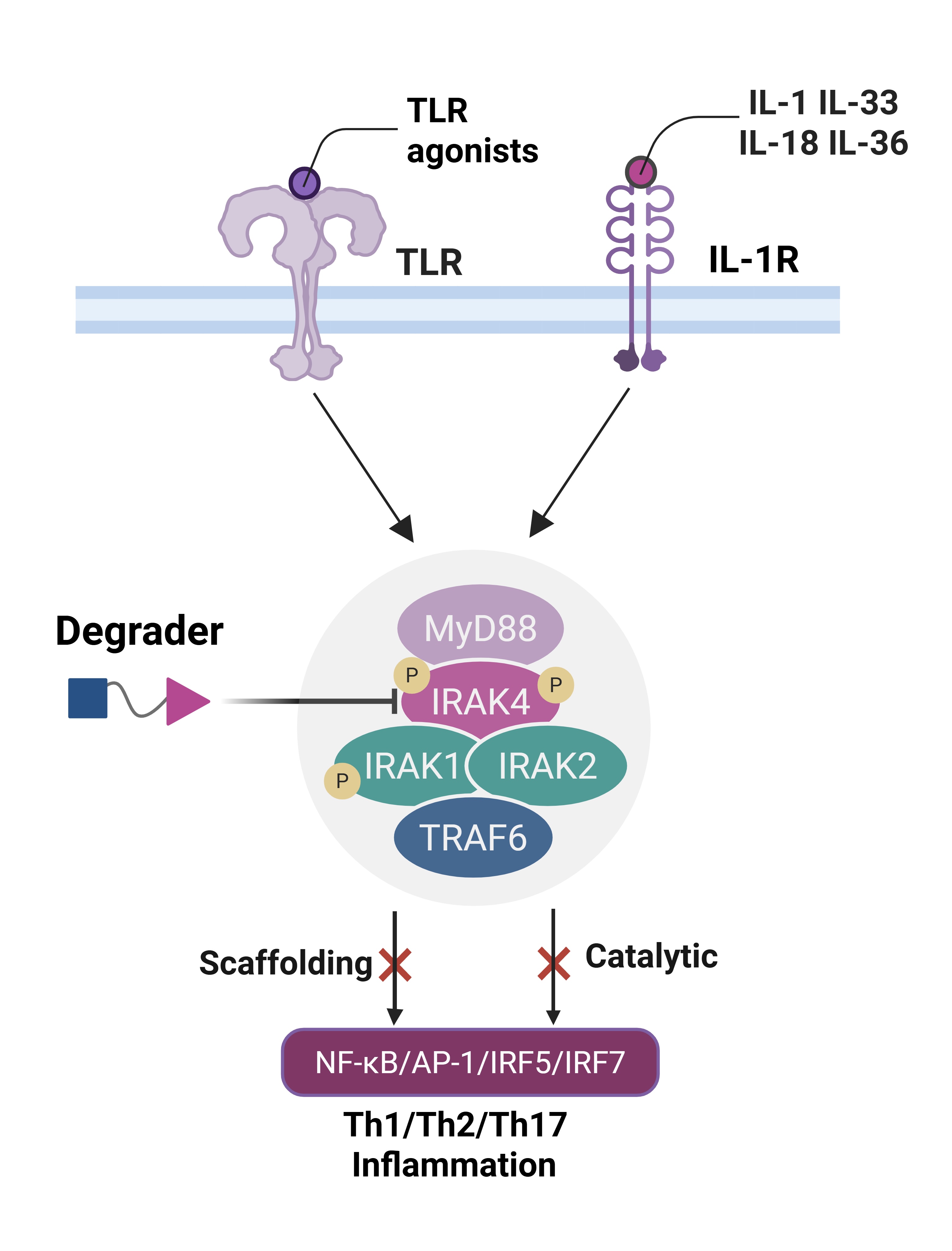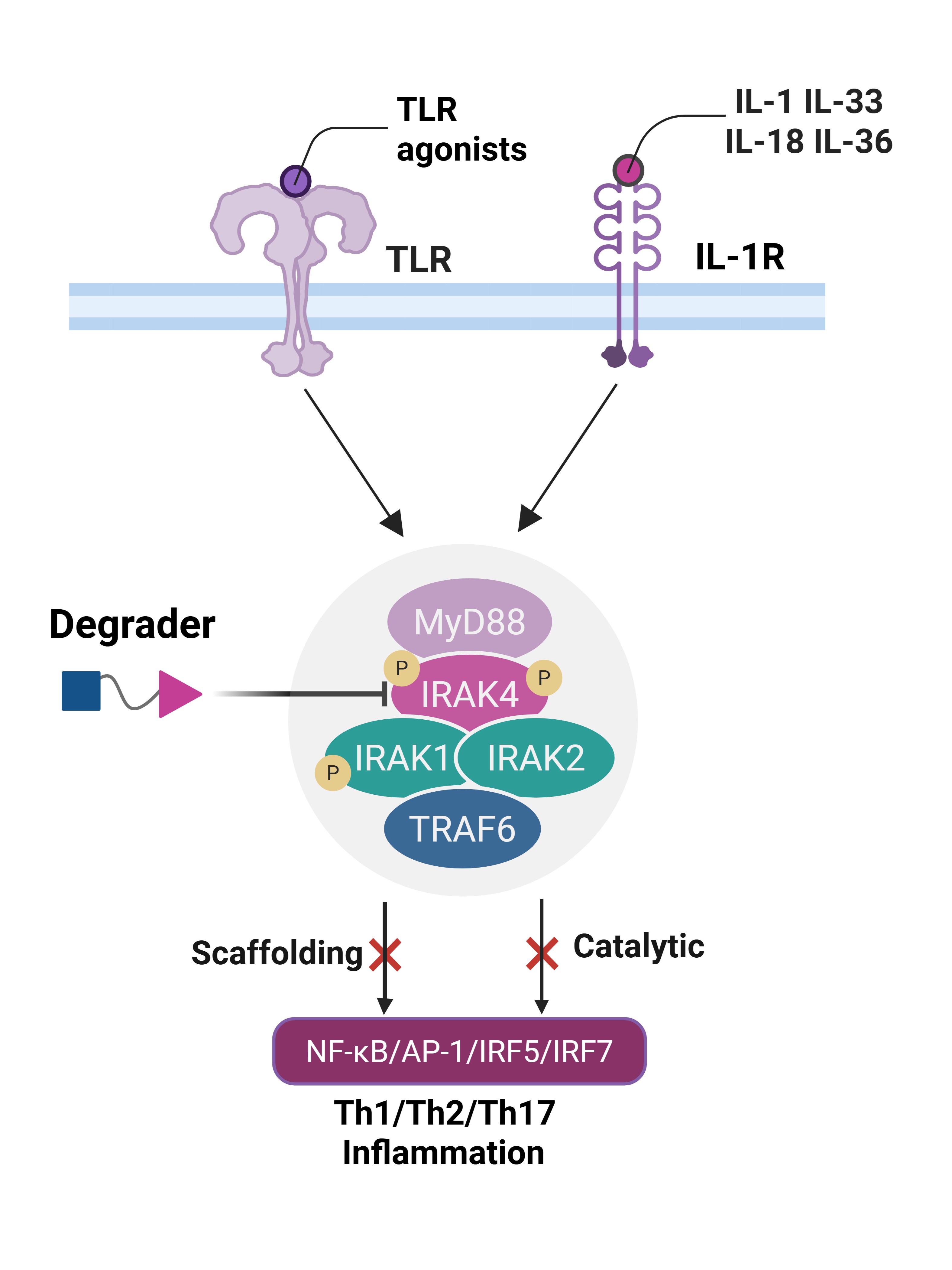Our R&D pipeline is strategically focused on high-impact therapeutic areas, including autoimmune diseases and oncology, with substantial market potential and distinct competitive advantages.
Through continued research across multiple innovative targets, we have made significant strides in our core program, P001. This includes the successful identification of several Preclinical Candidate Compounds (PCCs) that demonstrate strong performance in both in vitro and in vivo models across multiple indications.
Notably, our pipeline features a potential first-in-class molecule and a potential best-in-class molecule, underscoring our leadership and strategic vision in pioneering drug discovery.
We remain deeply committed to delivering transformative therapies to patients worldwide and driving advancements in health care.



PAM-194
Potential indications:AD, HS, IBD, PSO, PN, PPP.
Interleukin-1 receptor-associated kinase 4 (IRAK4), a pivotal regulator of the innate immune response and a central component of the myddosome signaling complex, serves as a critical mediator of interleukin-1 (IL-1) and Toll-like receptor (TLR) signaling cascades. Functioning as a scaffolding kinase, IRAK4 acts as a molecular bridge between the innate and adaptive immune systems, integrating signaling through its dual enzymatic and scaffolding activities. Complete degradation of IRAK4 abrogates both its kinase and scaffolding functions, thereby eliciting a broad spectrum of anti-inflammatory effects with favorable tolerability profiles. This mechanism represents an innovative therapeutic strategy for the treatment of immune-inflammatory disorders. Emerging clinical evidence demonstrates that IRAK4-degrading agents effectively recapitulate the biological activities of upstream biologic therapies. Target indications encompass a diverse range of diseases, including hidradenitis suppurativa (HS), atopic dermatitis (AD), psoriasis, inflammatory bowel disease (IBD), asthma, rheumatoid arthritis (RA), systemic lupus erythematosus (SLE), multiple sclerosis (MS), and others, in which dysregulated TLR/IL-1 signaling pathways contribute to disease pathogenesis.



PAM-815
Potential indications:SLE, IBD, RA, AD, HS, COPD, LN, Sepsis, DKD.
Interleukin-1 receptor-associated kinase 4 (IRAK4), a pivotal regulator of the innate immune response and a central component of the myddosome signaling complex, serves as a critical mediator of interleukin-1 (IL-1) and Toll-like receptor (TLR) signaling cascades. Functioning as a scaffolding kinase, IRAK4 acts as a molecular bridge between the innate and adaptive immune systems, integrating signaling through its dual enzymatic and scaffolding activities. Complete degradation of IRAK4 abrogates both its kinase and scaffolding functions, thereby eliciting a broad spectrum of anti-inflammatory effects with favorable tolerability profiles. This mechanism represents an innovative therapeutic strategy for the treatment of immune-inflammatory disorders. Emerging clinical evidence demonstrates that IRAK4-degrading agents effectively recapitulate the biological activities of upstream biologic therapies. Target indications encompass a diverse range of diseases, including hidradenitis suppurativa (HS), atopic dermatitis (AD), psoriasis, inflammatory bowel disease (IBD), asthma, rheumatoid arthritis (RA), systemic lupus erythematosus (SLE), multiple sclerosis (MS), and others, in which dysregulated TLR/IL-1 signaling pathways contribute to disease pathogenesis.












PAM-194
Potential indications:AD, HS, IBD, PSO, PN, PPP.
Interleukin-1 receptor-associated kinase 4 (IRAK4), a pivotal regulator of the innate immune response and a central component of the myddosome signaling complex, serves as a critical mediator of interleukin-1 (IL-1) and Toll-like receptor (TLR) signaling cascades. Functioning as a scaffolding kinase, IRAK4 acts as a molecular bridge between the innate and adaptive immune systems, integrating signaling through its dual enzymatic and scaffolding activities. Complete degradation of IRAK4 abrogates both its kinase and scaffolding functions, thereby eliciting a broad spectrum of anti-inflammatory effects with favorable tolerability profiles. This mechanism represents an innovative therapeutic strategy for the treatment of immune-inflammatory disorders. Emerging clinical evidence demonstrates that IRAK4-degrading agents effectively recapitulate the biological activities of upstream biologic therapies. Target indications encompass a diverse range of diseases, including hidradenitis suppurativa (HS), atopic dermatitis (AD), psoriasis, inflammatory bowel disease (IBD), asthma, rheumatoid arthritis (RA), systemic lupus erythematosus (SLE), multiple sclerosis (MS), and others, in which dysregulated TLR/IL-1 signaling pathways contribute to disease pathogenesis.


PAM-815
Potential indications:SLE, IBD, RA, AD, HS, COPD, LN, Sepsis, DKD.
Interleukin-1 receptor-associated kinase 4 (IRAK4), a pivotal regulator of the innate immune response and a central component of the myddosome signaling complex, serves as a critical mediator of interleukin-1 (IL-1) and Toll-like receptor (TLR) signaling cascades. Functioning as a scaffolding kinase, IRAK4 acts as a molecular bridge between the innate and adaptive immune systems, integrating signaling through its dual enzymatic and scaffolding activities. Complete degradation of IRAK4 abrogates both its kinase and scaffolding functions, thereby eliciting a broad spectrum of anti-inflammatory effects with favorable tolerability profiles. This mechanism represents an innovative therapeutic strategy for the treatment of immune-inflammatory disorders. Emerging clinical evidence demonstrates that IRAK4-degrading agents effectively recapitulate the biological activities of upstream biologic therapies. Target indications encompass a diverse range of diseases, including hidradenitis suppurativa (HS), atopic dermatitis (AD), psoriasis, inflammatory bowel disease (IBD), asthma, rheumatoid arthritis (RA), systemic lupus erythematosus (SLE), multiple sclerosis (MS), and others, in which dysregulated TLR/IL-1 signaling pathways contribute to disease pathogenesis.











